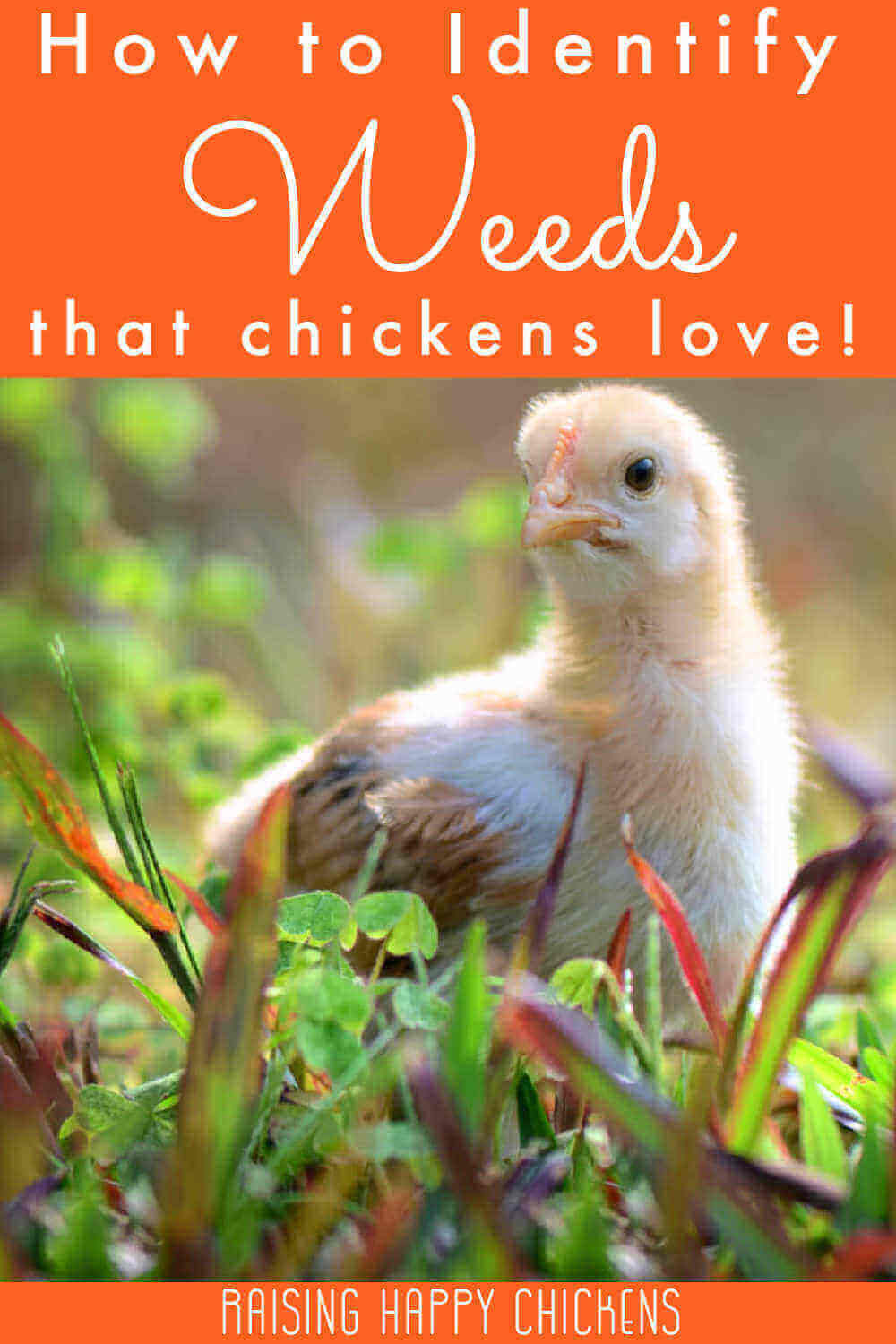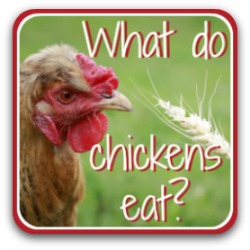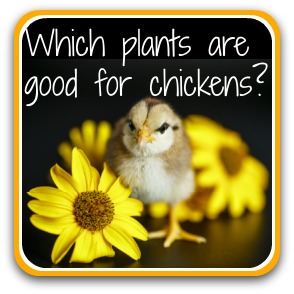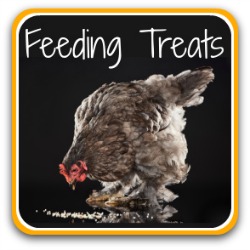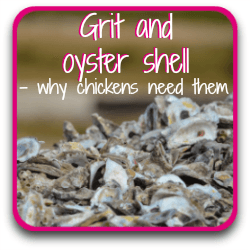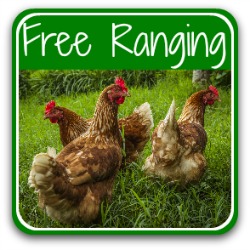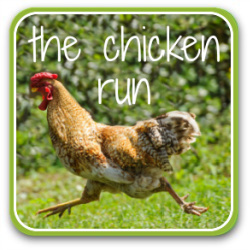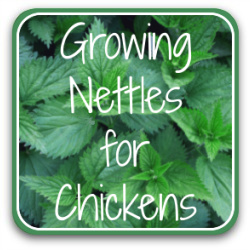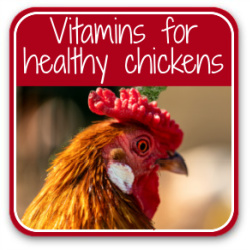- Home
- Plants for Chickens
- Weeds
Identifying weeds for chicken feed.
The right weeds can add free nutritious value to your flocks' diet. I identify six of the best - and one that could be fatal to your flock.
What are weeds?
The definition of a weed is any plant that's not somewhere you want it to be. Some are invasive and need controlling, but many plants we've come to view as weeds are actually beneficial and nutritious.
An obvious example are dandelions. Viewed as a pest when they appear in well-manicured lawns, they're full of nutritional value, loved by bees for their pollen, and can be used in salads, as a supplement to chicken feed - even in wine making!
Here, we look at six weeds which can add value to your flock's feed - and a yummy weed recipe you could make up today!
The chances are you have at least one of these weeds growing on or near your property.
All of them are stashed with vitamins and nutrients. And of course, unlike shop-bought vitamins and some other healthy treats, they're free for you to pick!
Identifying weeds.
Most weeds are common and easily recognisable. There are photos of every one in this article so you can be sure.
Harvest only from areas you know are free from pollutants, especially weed killer, and try to avoid those growing on busy roadsides where pollutants are airborne. Growing them in a patch of your own garden (or in pots on a balcony – there's always a way!) is the best solution, so you know for sure they're not contaminated.
Most are best fed fresh to your flock, so pick and process only the amount you're going to use within two or three days at most. Harvest young, tender plants which are easier for chickens to digest.
And always leave some. Weeds provide cover for insects, and pollinators like bees use many of them to produce the tastiest honey.
Here are the weeds I cover. Click if you want to jump to a specific section.
Tips for feeding weeds to chickens.
- If your chickens free range, they'll find weeds for themselves as they forage for edible grasses, bugs and seeds. They know instinctively which to eat and which to leave alone, and they know how much to eat to get the nutrients they need.
- Not everyone can free range their chickens. So having a stock of weeds to toss into the coop and run, particularly in winter when other greenery is sparse, is an ideal solution.
- Try to use a variety of different types of weed. If your flock were free ranging, they'd pick and mix.
- Offer as an addition to your usual feed, and don't over feed. As with any food, balance is important. Too much of even a good thing can be a problem for your chickens' digestion.
- Where there may be problems, you'll find them identified under each weed.
- And remember: chickens are individuals. They can be picky. Not every chicken will like every one of these weeds. The only way to know what they'll enjoy is to try a selection.
Types of weeds chickens love: common chickweed (Stellaria media).
It's not called chickweed for nothing – chickens love this common garden weed!
A hardy annual plant which can survive the coldest winter, you'll find it spreading quickly from February onwards. It loves bare, damp ground, preferably where you've recently dug, and is especially fond of spaces under trees.
It doesn't like heat though, so in hot, dry areas it will quickly die back.
Identifying chickweed: what does it look like?
You can identify it through its prolific, small, heart-shaped leaves which tend to be larger at the top than the bottom of the plant.
It has tiny, white rosettes of flowers sitting on five open petals which blossom in the early spring.
 Chickweed - so called because chickens love it!
Chickweed - so called because chickens love it!Benefits of chickweed.
Recognised by the Greeks and Romans as an early "super food" for its nutritional and medicinal value, chickweed is particularly high in minerals, especially potassium, without which chickens will fail to thrive.
Got a baby chick in trouble? Try feeding a small amount of chickweed in your brooder.
It's also high in Vitamins A, B complex, and C, all of which are essential for normal growth. They're also an immune system boost.
Chickweed is also known to have high amounts of gamma-linoleic acid, better known as Omega 6(1). Omega 6, along with Omega 3, not only provides essential fatty acid for hen health, it adds nutritional benefit to their eggs which, in turn, improves our own and our family's health as we eat them(2).
When and how to feed chickweed to your flock.
Use it as a winter feed. Although it reseeds quickly so in cool climates is available all year round, you'll probably find your chickens love it in the winter but aren't so keen in summer, when there are too many other delicious berries and fruits available.
Pull some up by the roots and throw into the run, or hang a bunch and leave them to it. No need to chop or prepare it – they love it just as it comes.
Any problems?
You may read that chickweed contains oxalic acid, which can interfere with calcium absorption. That's true, but it only prevents calcium absorption from plants which themselves contain oxalic acid.
So if your flock is eating nothing but chickweed, you have a problem.
But if they're getting a balanced diet, and have calcium from other sources – oyster shell, for example – you have nothing to worry about.
As in everything, aim for balance and moderation.
Invasive weeds: stinging nettles (Urtica dioica).
Everyone knows the common nettle plant – most of us have been stung by one at some point in our lives! It's another hardy perennial which appears as early as February, and it grows more or less anywhere, although it ideally prefers a rich soil with plenty of nutrients.
Nettles are an ideal plant for attracting wildlife to your garden. Butterflies use them as an important source of food, while ladybirds (ladybugs) hide in their foliage until they're mature enough to go out and eat all those aphids which would otherwise eat your plants.
Encourage a cluster of nettles in your garden as a wildlife corner and feed your chickens (and your family) at the same time.
I have a very detailed article about the stinging nettle, here. It's based on properly researched studies which fed different amounts of nettles to chickens and noted the outcome both for the chickens are their eggs.
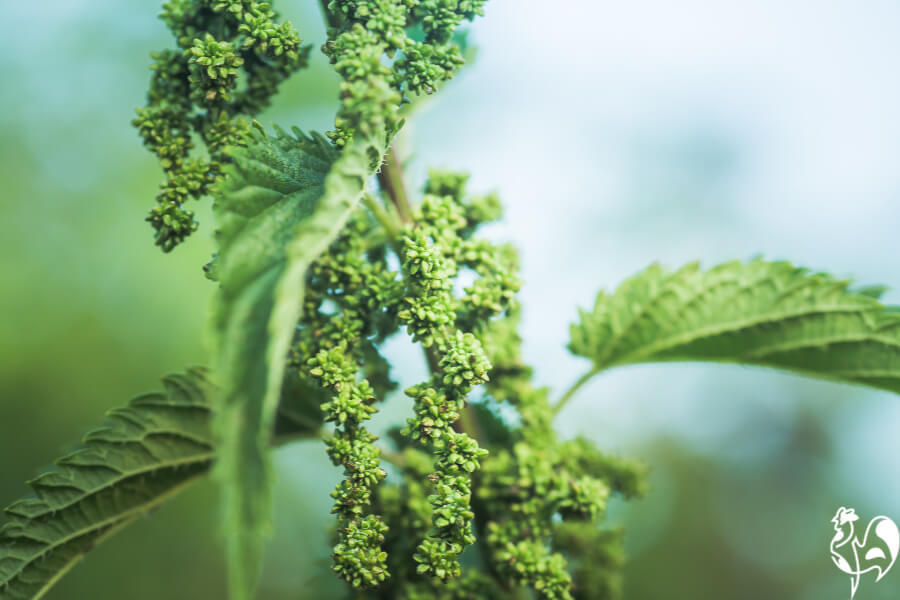 When the nettles are flowering, or if you see these clusters of seeds, stop picking.
When the nettles are flowering, or if you see these clusters of seeds, stop picking.Common Purslane (Portulaca oleracea).
The purslane plant is one of those that you have probably seen in your garden but thought it's just another highly invasive weed.
But it has amazing benefits for both humans and chickens, making a great addition to family salads as well as to chicken food. It's one of my favourite weeds to cultivate for my flock.
Identifying purslane.
Known also as red root or pursley (not parsley!), it's an annual plant which, if you don't already have, you can sow from seed as early as March and harvest a couple of months later. It grows best in a poor soil, and it can withstand drought so it's good for hot, sunny climes.
Its characteristic features are small, green, succulent leaves on a bright red stem which spread across the ground. In the summer it has yellow or pink flowers which open for just a short time, usually in the morning.
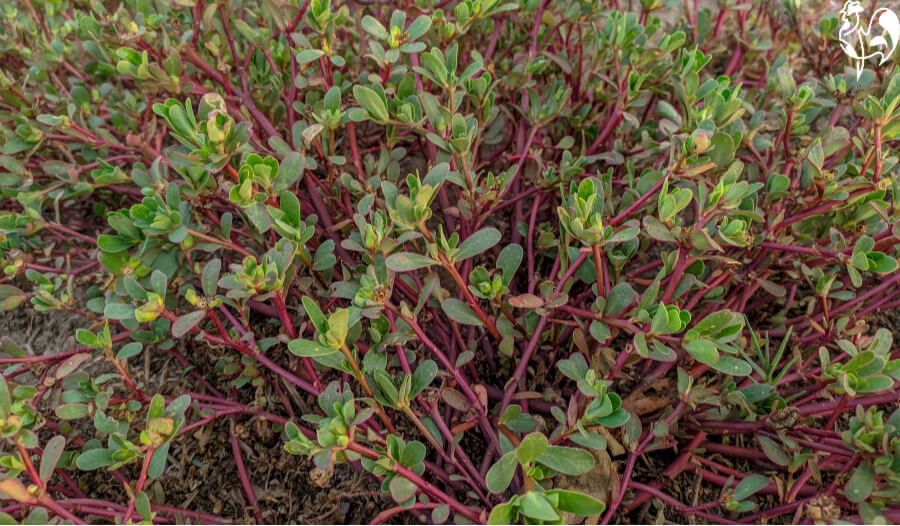 Common garden purslane: the distinctive red stems make it stand out from other weeds.
Common garden purslane: the distinctive red stems make it stand out from other weeds.Purslane's nutritional benefits.
Listed by the World Health Organisation as one of the most used medicinal plants, purslane has been mentioned in ancient works as far back as 372 B.C. as a remedy for conditions ranging from sore throats to heart failure.
Low in fat, enriched with iron and high in vitamins B and C, a study specific to chickens demonstrated that including purslane in poultry diets saw eggs enriched with omega-3 oils(4).
And omega-3 in our diets is scientifically proven to have multiple health benefits, including raising good cholesterol levels, helping fight anxiety and depression and maintaining a healthy immune system(5).
So, good for your chickens and good for you and your family!
When and how to feed purslane to your chickens.
All parts of the purslane plant are edible, including the flowers.
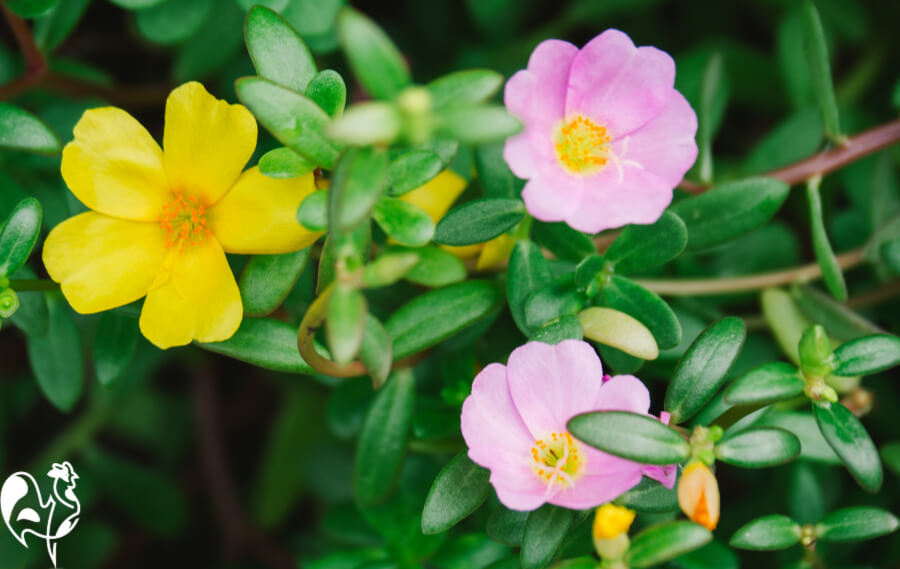 For a common weed, purslane is very pretty when in flower.
For a common weed, purslane is very pretty when in flower.It doesn't keep well, so only harvest as much as you need.
Scientific studies using purslane have fed by drying in a very cool oven for several hours. Or you can just pick bunches and throw into the run – chickens like eating it raw.
Any problems with purslane?
No. As with everything, though, feed in moderation and use as part of a balanced diet, not as their only food.
If you don't have purslane growing naturally in your garden, why not grow some? It's one of the best ways of increasing the amount of omega-3 in your hens' eggs.
And it's easy to sow, grow and maintain, even in hot climates.
(This is an "affiliate link", which means that if you click and buy something, I earn a small commission at no extra cost to you).
Fat hen, also known as pigweed or goosefoot (Chenopodium album).
It's known by different names in different places: pigweed, fat hen, goosefoot and lambs' quarters are just a few.
It grows freely round the edge of cultivated land, so if you're picking it from there be careful to check that pesticides haven't been used.
It's also commonly found by roadsides, in hedgerows and in gardens. It's in season generally between April and October.
Identifying pigweed.
This is an annual, upright plant with dull, blue-green leaves which sometimes have a hint of white underneath. The edges of the young leaf are serrated or "toothed", but not as sharply defined as the nettle. As the leaf gets older the serration tends to disappear and the leaf edge becomes smooth.
If you look closely at the leaves, you'll see a waxy substance which can make them appear to have a silvery sheen.
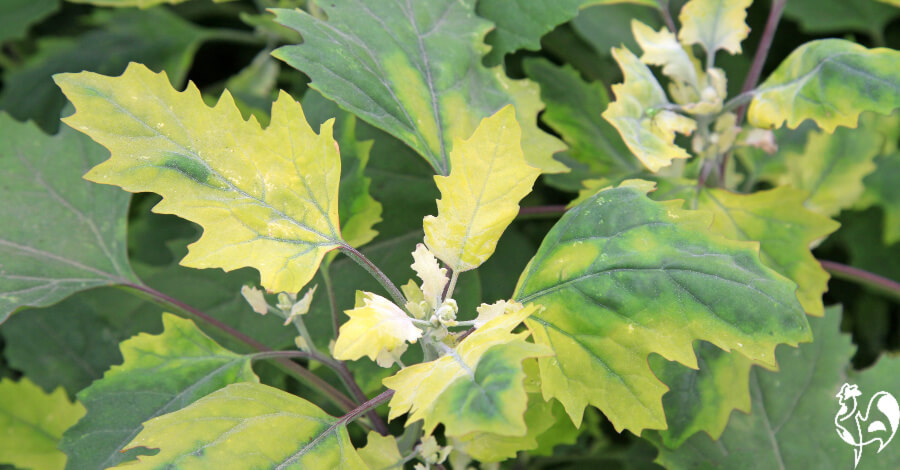 Fat hen, or pigweed. Not much to look at, but chickens love it.
Fat hen, or pigweed. Not much to look at, but chickens love it.Between June and October spikes of tiny white-green flowers grow from the junction between the leaf and stem. The plant can (but rarely does) grow as high as 150 centimetres (5 feet) but after flowering will tend to drop to the ground with the weight of the flowers and seeds.
Nutritional benefits.
Fat hen or pigweed is a member of the spinach family, and both the leaves and seeds are edible.
Used as a crop for different types of animals, it's very high in Vitamin A, phosphorous (critical to the egg-laying process) and potassium, and a good source of protein, iron, trace minerals and fibre.
It's another plant high in omega-3, too, so enhances the nutritional value of your eggs.
Its seeds, which are produced by the tens of thousands, are very like quinoa seeds – a close relative (Chenopodium quinoa) from south America. They're particularly loved by wild birds including the Greenfinch and Yellowhammer.
When and how to feed fat hen to your chickens.
As with most weeds, feed when they're young. As they get older, both the leaves and the seeds become more bitter and at that stage, chickens will avoid them.
Either feed the leaves as they are or, if you like to spoil your flock, steam them. Be careful not to over-feed these, as they do contain oxalic acid.
The seeds can be sprouted to release even more nutrients. See this article for instructions (clue: it's not difficult!).
Common weeds chickens love: Clover (Trifolium).
This is probably my favourite "weed", but for gardeners who love a pristine lawn it can be a nuisance – hence it's known generally as a weed.
It's a perennial plant that's easy to grow either as a lawn or part of a lawn. It will do well on any type of soil, including the poor soil often found around new houses.
How to identify clover.
It's usually three-leaved – if you find a four-leaved clover it will supposedly bring you luck! It's bright green and because it's drought tolerant, you'll find it even in the driest summers.
It grows low to the ground in a mat, and feels spongy underfoot. It will grow back well after harvesting.
There are different types of clover: the clover you want for poultry is either white (trifolium repens) or red (trifolium pretense). The colour refers to the distinctive flowers which blossom in the early summer.
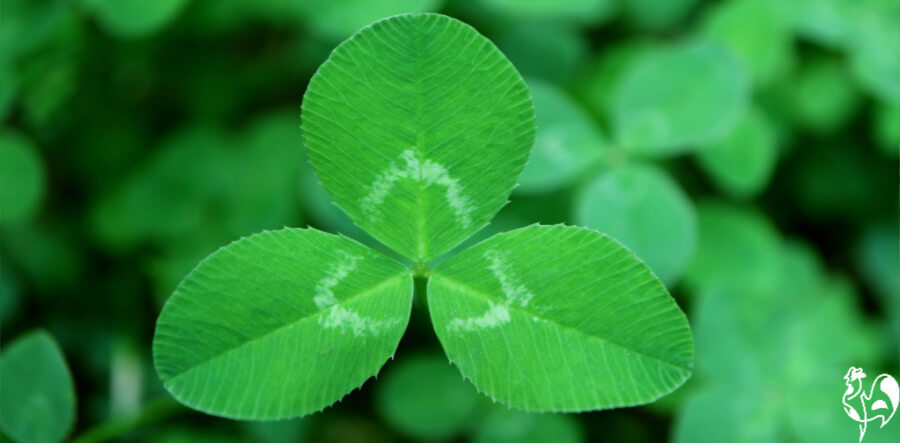 The 3-leafed clover - find one with 4 leaves and it's good luck!
The 3-leafed clover - find one with 4 leaves and it's good luck!The benefits of clover.
High in vitamins A and B complex and in niacin, potassium and iron, clover's big claim to fame is protein. Like dandelions, it improves the digestive, circulatory and respiratory systems.
And once again, eggs from hens fed on this weed have been found to be a whole 18% higher in omega-3 fat.
When and how to feed clover to your chickens.
Simple. Let them graze on lawns containing clover as soon as it appears in the late spring and early summer. The entire plant is edible, including the flowers when they blossom around early June.
And try picking the flowers and adding them to your nest boxes for a sweet smell and a healthy treat for the hens as they lay!
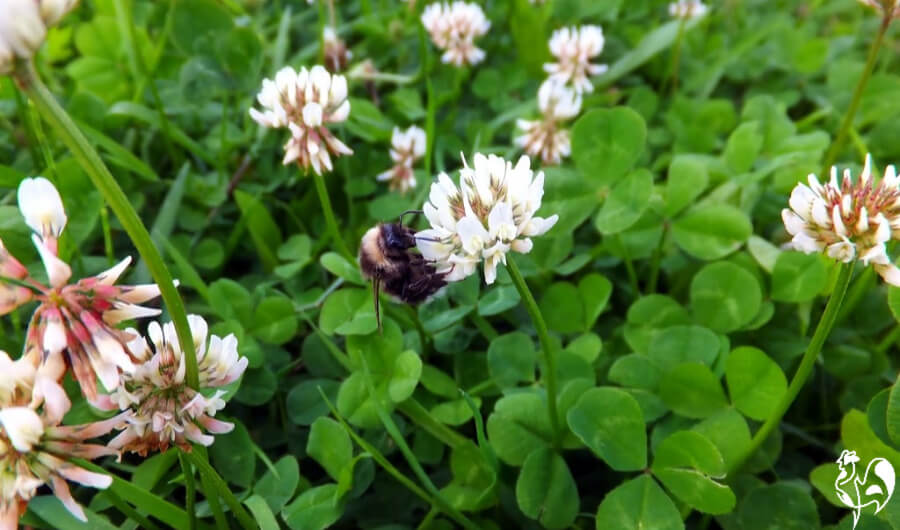 White clover flowers - bees use them to make delicious clover honey.
White clover flowers - bees use them to make delicious clover honey.Any problems with clover?
You may see information online saying that clover is poisonous for poultry. Not true, but...
- Sweet clover (Melilotus officinalis) is a totally different plant and does have a problem for chickens in that it contains a high level of coumarin. Coumarin is a chemical which reduces the ability of blood to clot. It smells of vanilla and you'll recognise it instantly if you crush the plant.
- If clover is cut and made into bales with other fodder, and the fodder gets wet, the mould can cause coumarin to turn into a toxin which can in turn cause internal bleeding.
So, don't feed sweet clover to your flock, and avoid any feed getting wet. Feed fresh, raw clover and you'll be fine.
Clover: why not grow your own?
Clover is so easy to grow, and so full of nutrients at times when other greens are lacking. Not only that, the flowers are a huge attraction for bees and butterflies.
Sow the seeds by scattering into your existing lawn, use them to create a new clover lawn, or sow in a box for your chickens, keeping the young plants under cover until they're well established.
As always, make sure your seeds are certified organic and non-GMO.
(This is an "affiliate link", which means that if you click and buy something, I earn a small commission at no extra cost to you).
Dandelion weeds.
I'm not going into much detail here about dandelions, because I cover them in a whole chapter in my free, downloadable book: "Raising Healthy Chickens" which you can get for free when you join my newsletter group.
 Leave some behind for the honey bees!
Leave some behind for the honey bees!Suffice it to say that dandelions are an amazing source of calcium (critical for laying hens), Vitamins A, B, C, E and K, and trace minerals including potassium and iron.
Not only that, but they're prolific – there are very few gardens that don't have dandelions! What's more, they're one of the first weeds to appear in the early spring, and one of the last to disappear in winter. So your flock need never go wanting for the goodness of a dandelion!
How to feed dandelions to your flock.
Chickens love the entire plant: leaves, stem, flowers and root.
They prefer dandelion leaves and flowers when they're young, during the spring and summer. Once they're older they become bitter and tough.
Snip the flowers off as soon as they blossom, and toss them into the coop.
The root is best fed later in the year when it's full of nutrients. If you break it open in late autumn (fall), you'll see a milky ooze. At this stage it's full of protein, at just the time of year when your chickens most need it as they moult and wind down for autumn and winter.
It will be hard to get out of the ground – it has a very long taproot. But it can be done!
Any problems?
No. As long as, of course, your flock has a balanced feed and dandelions, like the rest of the weeds, are fed as a supplement to their diet.
A delicious, nutritious weed recipe.
It's good to feed your flock a mixture of weeds once in a while. I use the following amounts, together with some other ingredients I know my flock like. This is enough for a one-off treat for a flock of about 24.
But you can use any of the weeds on this article, and any other plant-based favourites of your own chickens.
Simply mix everything together and serve in a bowl, separate from their usual feed. I tend to rip (not chop) the larger leaves.
This mix without the garlic will keep in a cool, dark place for a couple of months. But if you use garlic, don't keep it: the moisture from the garlic can create mould amongst the weeds.
One poisonous common weed.
The buttercup (ranunculus): pretty, but potentially dangerous for chickens.
Everyone loves buttercups. When I was young, we'd hold a buttercup under our chin to see whether we liked butter. If we did, we'd have a yellow shadow on our chin.
Of course, it would be easier just to taste butter... The yellow shadow happens simply because the buttercup's petals reflect light well.
So lots of people have fond memories of this common garden and meadow weed. But not chickens.
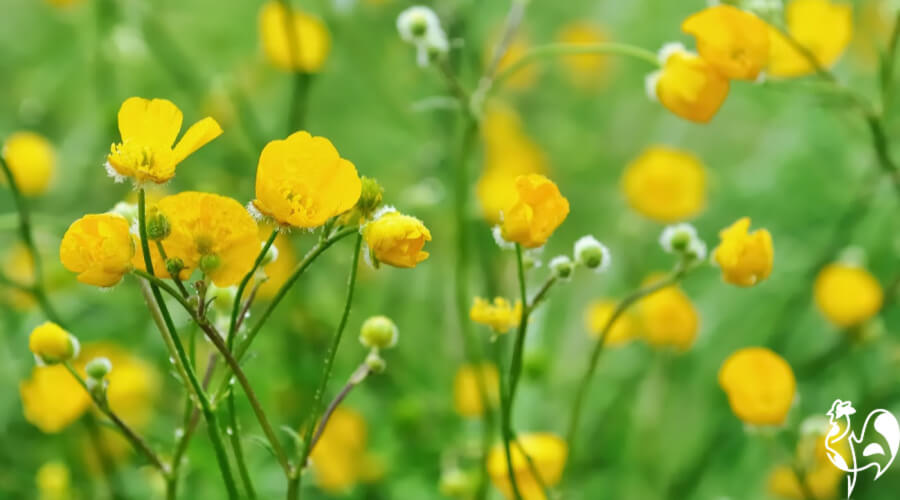 Buttercups: lovely to look at but potentially dangerous for chickens.
Buttercups: lovely to look at but potentially dangerous for chickens.All species of ranunculus are poisonous if they're eaten fresh, but the fact is they taste bitter and in mammals, cause mouth blisters. So most will go uneaten.
When it's squashed or even just handled, the plant releases protoanemonin which causes diarrhea and has been known to kill mammals, particularly sheep and cattle(6).
There are no specific studies about chickens and buttercups, but given that they cause dietary problems in other animals, they're best avoided.
Should you dig up all your buttercups?
No need, even if you could!
Chickens are generally very good at knowing what not to eat, certainly in terms of naturally growing foods. They're not so good at distinguishing things they don't instinctively recognise, like polystyrene for example.
They may have a peck at the flowers, attracted by the bright colour, but they won't carry on eating them.
So, don't actively offer buttercups to your chickens, but don't worry if they grow wild on your land.
Want to know about other plants that are good for your flock?
Watch this short video for more information.
If this article was helpful, these will interest you too!
Sources.
A lot of "facts" you'll find on the internet are people's individual views, often based on inaccurate information repeated from poor quality sources.
The information I provide in this article and others is based not just on my own experience, but on evidenced facts from scientific, peer-reviewed research and evidence from highly respected and experienced poultry keepers such as Gail Dammerow.
Some of the sources I have used are these.
1. Defelice, M: Common Chickweed: Mere Chicken Feed?. Pub. Cambridge University Press, 2017.
2. Alagawany, M, et al: Omega-3 and Omega-6 Fatty Acids in Poultry Nutrition: Effect on Production, Performance and Health. Pub. US National Library of Medicine, 2019.
3. Wetheril, H: Nutritional evaluation of the Urtica species. Pub. CRC Press, 2003.
4. Aydin, R and Doogan, I: Fatty acid profile and cholesterol content of egg yolk from chickens fed diets supplemented with purslane. Pub. Journal of the Science of Food and Agriculture, 2010.
5. Hjalmarsdottir, F: 7 science-based benefits of omega-3 fatty acids. Pub. Healthline, 2018.
6. Israel, T, and Rhodes, Professor G: Buttercups. Pub. University of Tennessee, Institute of Agriculture, 2015.
- Home
- Plants for Chickens
- Weeds
